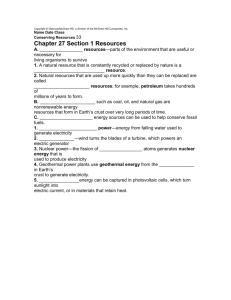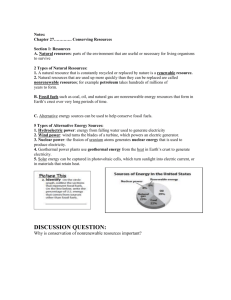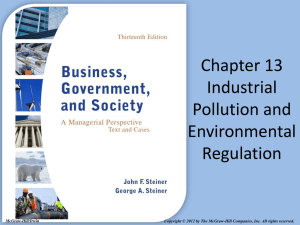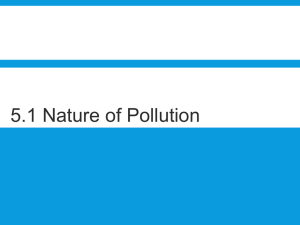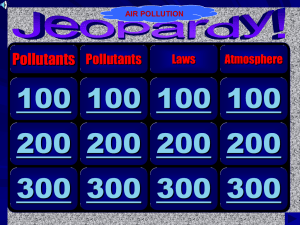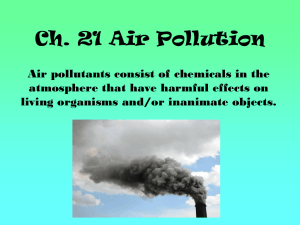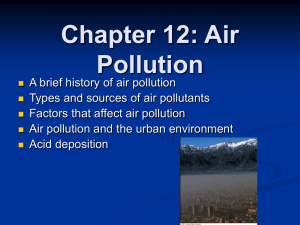Review for Final
advertisement
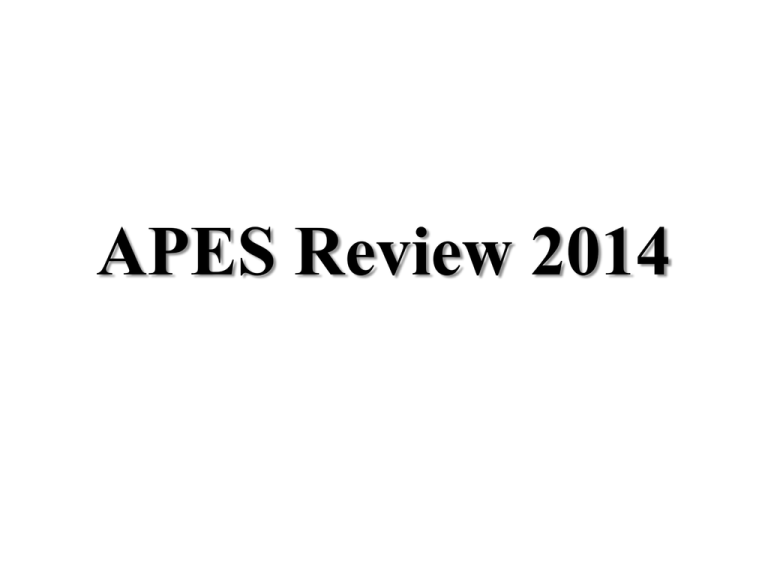
APES Review 2014 The depletion of the world’s marine fish stocks due to overfishing is an example of: A. The sustainable use of resources. B. The trap-door principle. C. The eminent domain principle. D. The failure of international treaties. E. The tragedy of the commons. Ammonium ions are converted to nitrite ions and nitrate ions through the process of A. nitrification. B. leaching. C. denitrification. D. assimilation. E. nitrogen fixation. You have been studying a large lake ecosystem. You learn that PCBs have been dumped into the water. You predict that the most effected population would be the A. algae B. small fish C. zooplankton D. ducks E. predatory birds Ionizing radiation includes all of the following EXCEPT A. ultraviolet radiation. B. neutrons emitted by nuclear fission. C. alpha radiation. D. infrared radiation. E. X rays. In a developing country, you are most likely to fear health threats from A. hantavirus B. diabetes C. cancer D. unsanitary drinking water E. Ebola virus Most plastics are classified as ________ pollutants A. Degradable B. Biodegradable C. Nonpersistant D. Nondegradable E. Slowly degradable This diagram is an example of: A. neutralization B. biomagnification C. eutrophication D. non-point source pollution E. point source pollution Plants and trees can be cut down and replanted. These resources are therefore considered to be A. Renewable resources B. Nonrenewable resources C. Perpetual D. Exhaustible resources E. Sustainable The National Environmental Policy Act (NEPA) ________. A. altered the amount of chemicals allowed in water as a result of industrial pollution B. put all federal land under stringent environmental protection C. was signed into law by Bill Clinton D. requires compensation to be given to anyone harmed by deliberate pollution from any business or corporate entity E. required environmental impact statements for any projects funded by the U.S. government An ecological footprint is defined as A. The impact an individual may have on a given area of land B. The amount of biologically productive land and water needed to sustain an individual within a population C. The carrying capacity of the earth for a given population D. The amount of land and water that has been converted to nonproductive use within a given geographical region Point pollution sources A. Can usually be identified within a given area B. Can never be located C. Are dispersed and difficult to identify D. Are much more expensive to control than Nonpoint sources E. Cannot be controlled The maximum population of a particular species that a given habitat can support over a given period of time: A. succession capacity B. impact capacity C. doubling capacity D. carrying capacity E. reserve capacity Matter is anything that A. Has mass and takes up space B. Gives off energy C. Is a solid at room temperature D. Cannot be chemically changed The economic theory that claims that the best way to alleviate poverty and to grow the economy is known as A. Trickle-down theory B. Narrowing the wealth gap C. Capitalism D. Social engineering During an El Niño-Southern Oscillation (ENSO), A. surface water along the South and North American coasts becomes cooler. B. upwellings of cold, nutrient-rich water are suppressed. C. prevailing easterly winds weaken. D. upwellings of cold, nutrient-rich water are increased. E. upwellings of warm, nutrientpoor water are suppressed. Deserts typically occur in a band at 30 degrees north and south latitude because A. descending air masses tend to be cool and dry. B. trade winds have a little moisture. C. water is heavier than air and is not carried far over land. . D. ascending air tends to be moist E. these locations get the most intense solar radiation of any location on Earth Climate is the general pattern of weather over a period of at least A. 30 years. B. 20 years. C. 50 years. D. 10 years. E. 40 years. A nuclear change in which two isotopes form a heavier nucleus is known as A. Nuclear fission B. Nuclear reaction C. Radioactive decay D. Nuclear fusion E. Critical mass Which of the following is an external cost of car ownership? A. the markup paid to the car dealership B. the cost of adding pollutants to the air by driving C. the price of the gasoline needed to run the car D. the price of car repairs The precautionary principal A. States that we need to watch consumerism in countries in which the population is growing B. Describes the pattern in which a shared reource tends to be degraded C. Defines the movement of toxic fatsoluble substances through the food chain D. Says that chemicals should be proven to be safe before being put on the market E. Shows that k-selected species tend to remain near the carrying capacity and tend not to have crashes An r-selected species generally: A. has a low biotic potential B. is small and short lived C. survives to reproduce D. gives much parental care to its offspring E. lives in a stable environment The country of Belize depends on lobster for a major portion of its income, along with fishing and tourism. Over the past 30 years the average size of an individual lobster has dropped, even as increasing numbers of Belizeans buy boats, build lobster traps, and enter the industry. This is an example of ___. A. habitat alteration B. effects of pollution C. overharvesting D. results of an invasive species E. problems with monoculture Most of the world's forests occur as ________. A. temperate rainforest B. chaparral C. tropical dry forest D. temperate deciduous forest E. taiga and rainforest Freshwater resources are __. A. mostly used for drinking B. used primarily for crop irrigation C. inexhaustible because of the hydrological cycle D. concentrated in the western United States E. not necessary for our ultimate survival Which of the following is NOT one of the common phosphorous reservoirs in the ecosystem? A. atmosphere B. organisms C. rocks D. marine sediment E. soil Activities allowed in the (U.S.) National Wild and Scenic Rivers System include which of the following? I. fishing II. kayaking III. motor boating A. I only D. I and II only B. II only E. II, and III only C. III only The single, most frequent irrigation method is (in an agricultural use): A. Gravity flow B. Drip C. Center pivot D. Lateral pivot The most efficient irrigation method is (in an agricultural use): A. Gravity flow B. Drip C. Center pivot D. Lateral pivot Which of the following types of species is least vulnerable to habitat fragmentation? A. generalists B. specialists C. large predators D. migratory species E. species requiring large territories. An organism carrying a disease which may be transmitted to humans is called a A. vector. B. transfer agent. C. bug. D. carrier. E. causative agent. Under the provisions of the Clean Air Act, priority pollutants are: A. Pollutants that do the most harm to the air quality. B. Air pollutants that are most commonly generated C. The most toxic air pollutants D. Air pollutants from factories and hazardous waste sites E. Air pollutants from non-point sources Inorganic nitrogencontaining ions are converted into organic molecules through A. assimilation. B. leaching. C. nitrification. D. nitrogen fixation. E. denitrification. Life on earth depends on interaction of gravity, the cycling of matter and A. the destruction of matter. B. the consumption of matter. C. one-way flow of energy. D. cycling of energy. E. one-way flow of matter. Which of the following ecosystems has the lowest level of kilocalories per square meter per year? A. lakes and streams B. agricultural land C. temperate forest D. tropical rain forest E. open ocean Selection systems are timber harvesting methods that ____. A. are ecologically harmless B. very popular with timber companies C. leave seed-producing or mature trees D. are the most cost efficient in the short term E. have the greatest impacts on forest ecosystems Plants of the arctic tundra are adapted to A. freezing temperatures, lack of sunlight, and constant high winds. B. freezing temperatures, lack of water, and lack of sunlight. C. moderate temperatures, lack of sunlight, and constant high winds. D. freezing temperatures, lack of water, and bright sunlight. E. freezing temperatures, lack of water, and variable winds. Most of the wetlands that are lost are used for A. mining. B. recreation. C. forestry. D. urban development. E. agriculture. In lakes, the nutrient-rich water near the shore is part of the A. limnetic zone. B. benthic zone. C. profundal zone. D. abyssal zone. E. littoral zone. Forests reach their greatest ecological complexity when ____. A. they are frequently logged using clear-cutting B. in the early stages of recovering from logging C. shrubs and other ground cover plants are absent D. they are frequently burned E. they are mature and exhibit a multi-level canopy All of the following are examples of sustainability EXCEPT A. Renewable Energy B. Population Stabilization C. Urban Development D. Climate Control E. Water Conservation A group of individuals of the same species occupying a given area at the same time is called a A. species B. population C. community D. genus E. subspecies A _____ feedback loop causes a system to change further in the same direction. A. Negative B. Corrective C. Nominal D. Positive E. Polarized The major cause of decreased inland wetland areas in the United States is: A.the internal combustion engine automobile B.chlorofluorocarbons in cleaning solvents C.agricultural practices and approaches D.sulfur dioxide from coal-fired power plants E.forestry and mining practices Estuaries exhibit A. constant temperature. B. variable temperature and constant salinity. C. constant temperature and salinity. D. variable temperature and salinity. E. constant temperature and variable salinity.




